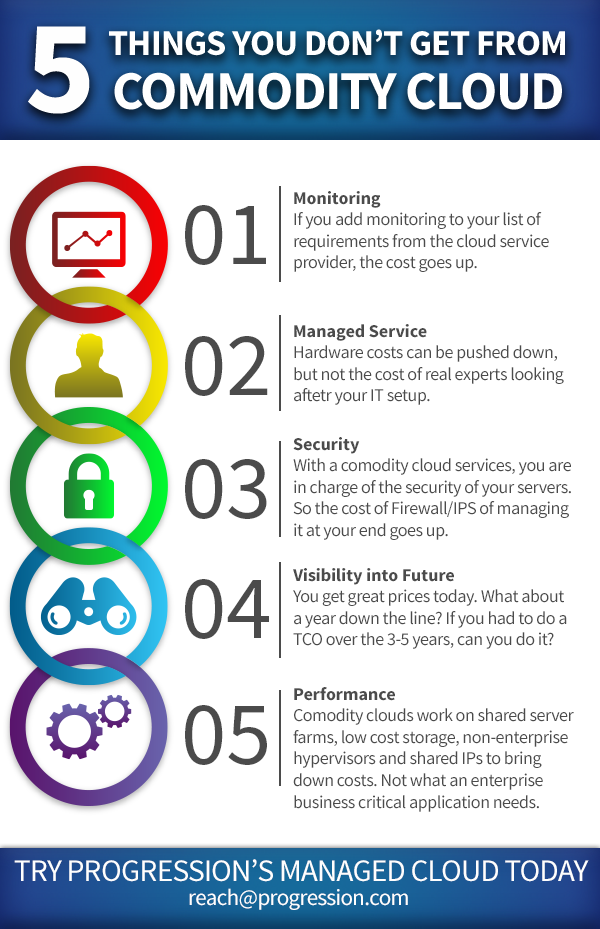Cloud computing is cheap, nearly free in many cases, and has given birth to a class of cloud called the commodity cloud.
It does sound good for the customer. To quote Techcrunch, “…how long can CIOs ignore pricing as it goes this low? It doesn’t make good business sense, and whatever risks a large enterprise believes they might face with cloud services, it has to be offset by the plunging costs.”
While it sounds good, at some point, value becomes far more important than cost. A large enterprise, or a rapidly growing medium-size enterprise really cannot afford halting of business processes, for too long. Here are five things that the low pricing models cannot afford to deliver to your business.

1. You don’t get the monitoring your business demands
Your servers and storage come at ridiculous prices. But you also need to know that some business process is showing abnormal usage, and if it continues, you’ll need to add more storage or server capacity. It may be a process known to the business, like some increased email activity for a short duration. Or it could be unknown. But your IT team needs to know and take the right action.
Chances are that if you add monitoring to your list of requirements from the cloud service provider, the cost goes up, maybe just a little bit. If your business works round the clock, for example, like a manufacturing plant that works multiple shifts, you’ll need round-the-clock monitoring as well.
Chances are your costs now start looking less competitive.
So ask yourself these questions:
- Do we need monitoring of our IT infra on cloud?
- Do we need round the clock monitoring?
A small business can answer ‘No’ to both. But most mid-sized companies running critical business applications like SAP, Oracle Ebiz, Axapta or Navision simply cannot. They need monitoring and expert monitoring at that. When you ask for expert monitoring from commodity cloud providers, be ready for either a stiff hike in the bill, or be up against lack of skills and capabilities.
2. It’s not managed
That brings us to the Managed Services part. You can bring down the prices of hardware, and to some extent, software as well. But real experts, real people looking after your IT setup? They come at a price. And they very well should! If there’s an issue related to your SAP infra, you need an SAP expert to be looking into it. If you run a Unix environment, you need Unix experts, and experts in the flavour of Unix you run. That cannot come at near-free costs.
Progression is at the forefront of the Managed Services domain, with many companies trusting us to solve their IT infrastructure challenges related to business critical applications.
3. It’s not secure
With commodity clouds, you are in charge of the security of your servers. You won’t even know if your resources have been compromised till your work starts getting affected. And more often than not, as resolution, you may have to get a new server and start over. Enterprise applications cannot be handled in this manner. You need different levels of security, starting from physical security of the building itself, and controlled access to racks. Progression also deploys state-of-the-art intrusion prevention and network security systems, which are monitored round the clock. So issues are caught well before they can turn into threats or impact performance.
4. You don’t get performance
Commodity clouds work on shared server farms and use uncontrolled public networks to bring down costs. But is that what an enterprise business critical application needs? You need enterprise class resources, which are tried and tested. What you don’t need is commodity hardware running sub-optimal software. What you don’t need is ramshackle basements or warehouses pretending to be data centers.
You need an enterprise cloud with state-of-the-art infrastructure, not just for the IT parts, but also, the air conditioning, power, and the building itself.
(Download our checklist for How to choose a Cloud Service Provider)
5. What’s the long-term like?
You get great prices today. What about a year down the line? Will there be a ‘new & improved’ pricing plan? Do you know what costs will remain the same, and what are likely to go up significantly? Do you have the visibility to predict the cost as your business needs grow? If you use the same costing matrix as has been offered to you today by a commodity player, will it show the real budgets you should be working with?
If you had to do a TCO over the next 3-5 years, can you do it? In fact, as an IT strategist, all CIOs and IT Heads must do these calculations, based on real prices from the IT infra companies, and not by simply adding a small percentage increase on today’s costs.
Experts agree that cloud price wars do not bode well. Ron Miller of Techcrunch says, “The price of computing plunges with the prices offered to consumers, but no matter how low the cost of the hardware, it will never be zero – and the Big Three infrastructure players have to decide at some point if they can continue to play this increasingly dangerous game.”
Matt Weinberger of Citeworld says, “I think that just as there’s a case for going to Whole Foods when you absolutely, positively need GMO-free, pesticide-free, free trade, small batch coffee, there’s always going to be room in the market for a pricier cloud that delivers premium features. In other words, there’s more to a cloud than just the price tag.”
In short, you do not choose your cloud based on price alone, or cheaper isn’t always better. Look for a solution that works for your business, in the long term.


